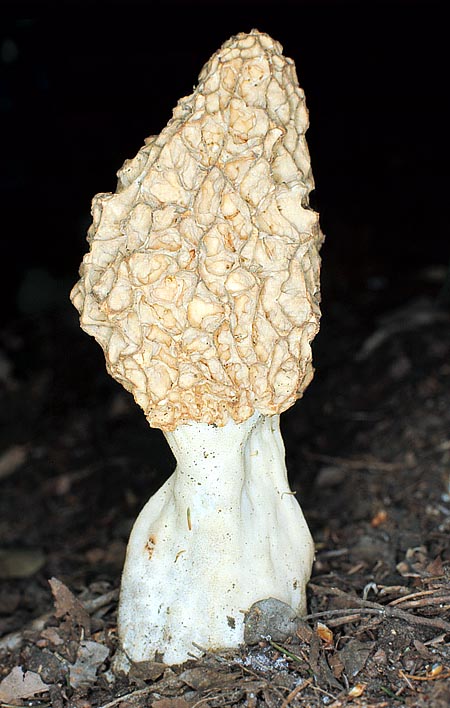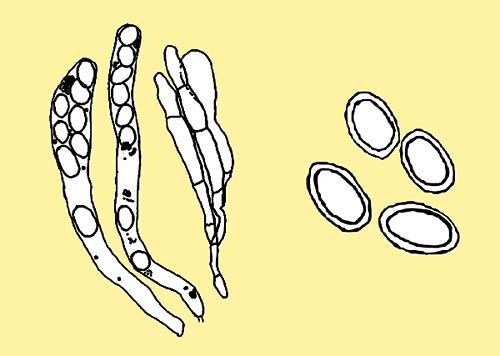
Text © Pierluigi Angeli

English translation by Mario Beltramini

Morchella esculenta is edible only after long cooking © Giuseppe Mazza
Family: Morchellaceae L. Reichenbach 1834.
Genus: Morchella Dillenius ex Persoon 1794.
Morchella esculenta (Linneo) Persoon. 1801.
The name “esculenta” comes from the Latin “esculentus” which means “edible”.
The Morchella are much sought fungi in spite of being edible only after cooking; consequently also the vulgar names are many: we mention here the most common ones. In Italy, it is known as spugnola, rocchetto; in France as morille blonde, morilel comestible; in Spain as morilla, morel, cagarria; in Germany as Speise-Morchel, Rund-Morchel; in England as common morel, morel, yellow morel, true morel, morel mushroom and sponge morel.
Description of the genus
To the genus Morchella are ascribed spring mushrooms, terricolous, saprotrophic, of medium and large size. The carpophores present a honeycomb-like cap that may be conical, globulous or roundish and cylindroid stem, whitish, granulous or furfuraceous, at times compressed or grooved. The cap has the surface formed by irregularly shaped pits, symmetrical as well as asymmetrical; the edge is attached to the stem by means of a vallecula (annular depression separating the base of the cap from the summit of the stem). The flesh has waxy, elastic, fragile consistency. The spores are smooth, ellipsoidal, and yellowish in mass.
Description of the species
Small, medium or big sized stipitate ascocarp.
Ascoma: from 40-60 mm up to 150-200 (300) mm of height, and 30-50 (80) mm of breadth, more or less deep cap formed by polygonal, irregular, wide and more or less deep apothecia; united by ribs in relief.
Hymenophore: placed inside the alveoli, is smooth, yellow, yellow-cream, with concolorous ribs.
Stem: cylindroid, wider at the base, at times ribbed or partially grooved, furfuraceous, granulous, whitish, ochraceous; hollow.
Flesh: elastic, ceraceous, ochraceous. Mild taste, spermatic odour.
Habitat: it grows in the humid and cool zones, in particular in the riparian ones, in presence of elms, ashes or rosaceous plants.
Edibility: edible after long cooking; the raw or little cooked Morchella are toxic.
Microscopy: elliptic, smooth, hyaline, uniseriate in the ascus, 16,78-19,68 (21,60) × 10,02-13,50 µm, Qm =1,64. Non amyloid, eight spores asci, 300-350 × 16-17 (20) µm, Septate, at times bifurcate, slightly widened at the apex 14-15 (18) µm, paraphysis.
Remarks. The dimensions of the ascocarp, the shape of the cape, the colour and the arrangement of the apothecia change depending on the varieties; more or less recognised of this species:

Asci, paraphysis and spores © Pierluigi Angeli
►Morchella esculenta var. rotunda (Persoon) P. E.M. Fries, of medium or big size, mainly round cap, of pale yellow, yellow-brown or ochraceous colour; large and irregular pits, thin ribs, concolorous but staining rust with the age. More or less cylindrical stem, slightly wider at the base, pruinose, whitish with ochraceous spots at the base.
►Morchella esculenta var. vulgaris (Persoon) A. Gennari, of medium-small dimensions, more or less rounded to sub-conical or ovoid cap, flattened at the top, grey-brown or brown-olivaceous colour, irregular pits, elongated, not too deep, more marked ribs, arranged in more or less regular longitudinal lines. Robust stem, widened at the base and ribbed, cream white, slightly furfuraceous.
►Morchella esculenta var. rigida (Krombholz) I.R. Hall, P.K. Buchanan, Y. Wang & Cole, of medium big size, with the stem prevailing in respect to the cap; sub-conical flattened at the summit cap, straw yellow to orange ochre yellow, wide and little deep pits, robust ribs, them too yellow or slightly rusty. Elongated stem, cylindrical, enlarged at the base, whitish and very pruinose.
►Morchella esculenta var. crassipes (Ventenant) Kreisel, much similar to the var. vulgaris, distinguishers from the same due to the bigger size and the base of the stem, decidedly widened and massive.
►Morchella esculenta var. umbrina (Boudier) S. Imai, small, irregularly round to ovoid cap, of brown, reddsh brown, blackish brown colour, irregular polygonal tips, little deep, thin ribs, very pale. More or less cylindrical stem, white, at times rust stained.
Similar for the appearance and the pitted cap to Mitrophora semilibera and Verpa bohemica, distinguishes from them for the stockier overall look, the always more or less enlarged at the base stem and especially due to the junction of the cap to the stem, placed at the base of the same. In Mitrophora semilibera, as the name states, the cap attaches to the stem at about the half of its height and in the Verpa bohemica the junction is placed at the apex of the cap.
Synonyms: Phallus esculentus Linneo, 1753 (basionym); Helvella esculenta (Linneo) Sowerby, 1797; Morellus esculentus (Linneo) Eaton, 1818; Morchella rotunda var. esculenta (Linneo) Jacquetant, 1985.
→ For general notions about Fungi please click here.
→ To appreciate the biodiversity of MUSHROOMS please click here.
